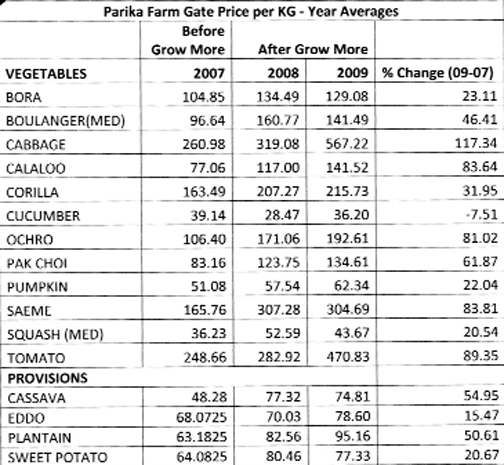Dear Editor,
Guyana Marketing Corporation (GMC), the lead agency in coordinating the Grow More Food Campaign, has been following a series of articles and more recently an editorial on this much hailed and beneficial strategic policy action. I would not indulge in suggesting the true motives for this seemingly unreasonable and biased representation of the benefits and import of this campaign to expand national and regional food security as well as to improve the economic status of our farmers, particularly our small farmers, but I would just to say that regional and multilateral institutions have hailed this campaign and in fact have used it as example for several Caricom states. In your editorial haste to create a negative spin, certain key facts and contexts were ignored or perhaps deliberately omitted.
Guyana’s Grow More Food Campaign had as its objectives:
* To ensure Guyana’s food security during the period when rising fuel prices were causing food prices to raise and food was becoming less accessible to many persons globally [2007-8];
“For the first time in history, there is a clear link between the price of fuel and the price of food,” said John Powell, the UN World Food Programme’s (WFP) deputy director of external programmes in Rome.
* To maintain its presence in existing markets and captitalise on new market opportunities;
Launched under a ‘market-led’ approach on March 29, 2008, the Grow More Food campaign consisted of a five-step plan:
1. Implementation of a US$21.9M Agricultural Export Diversification (ADP) Project.
This project is currently being implemented by the Agricultural Sector Development Unit of the Ministry of Agriculture. Key aspects of this project include the formation of three clusters; fruit and vegetables, aquaculture and livestock. This project aims to increase Guyana’s export growth rate and reduce its volatility by focusing on developing commodity chains on nontraditional agricultural products through the value chain approach.
2. Implementation of US$6M Rural Enterprise & Agricultural Development (READ) project.
This project is also being implemented by the Agricultural Sector Development Unit of the Ministry of Agriculture. Key aspects of this project include working with rural communities to build their capacity to capitalize on market opportunities. The overall goal is to improve the livelihood of vulnerable communities.
3. Increased investment in drainage and irrigation. Restoring drainage to areas abandoned by farmers. Over the last two years more than $5 billion has been spent. Training farmers to manage the maintenance of rehabilitated structures.
4. Enhanced extension service.
The extension service has been revamped to enhance its service to the farmers and through the acquisition of vehicles, more qualified officers from Cuban and other agricultural institutions, and training for all of the Ministry of Agriculture’s staff, they are more capable of responding to the farmers’ needs and bridging the gap between farming and the transfer of technology.
In fact, when there are meetings between officials of the Ministry of Agriculture and its agencies and farmers, we sometimes see more officials than farmers at these meetings.
5. Increased availability of seed and planting materials.
The increased availability of seed and planting materials and improved livestock breeds has led to the increase of food availability both for local consumption and for export.
Below, statistics will show this increase in exports.
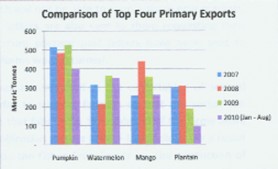 Further, a comparison of the exports of the top primary products reveals that the exports have increased for most of the commodities ranging from 2.7% in the case of pumpkin to as high as 949% in the case of coconuts, when comparing the end year volumes in 2007 to those of 2009.
Further, a comparison of the exports of the top primary products reveals that the exports have increased for most of the commodities ranging from 2.7% in the case of pumpkin to as high as 949% in the case of coconuts, when comparing the end year volumes in 2007 to those of 2009.
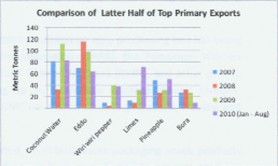 As a result of the work undertaken by the government through the Grow More Food Campaign (which started in 2008), exports for the Other Crops sector since the campaign have increased by 32.4% ie, from 7,116 metric tonnes in 2008 to 9,423 metric tonnes in 2009. Further for the first half of 2010, exports currently stand at 7,640 metric tonnes, ie, more than the overall total for 2008 and are projected to exceed those of 2009. These increases have mostly gone to our traditional markets but new markets have also been tapped into since the campaign, such as the Dominican Republic and Aruba.
As a result of the work undertaken by the government through the Grow More Food Campaign (which started in 2008), exports for the Other Crops sector since the campaign have increased by 32.4% ie, from 7,116 metric tonnes in 2008 to 9,423 metric tonnes in 2009. Further for the first half of 2010, exports currently stand at 7,640 metric tonnes, ie, more than the overall total for 2008 and are projected to exceed those of 2009. These increases have mostly gone to our traditional markets but new markets have also been tapped into since the campaign, such as the Dominican Republic and Aruba.
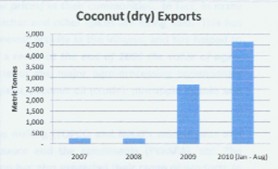 The government has recognized that markets are essential for farmers since domestic production exceeds domestic needs. As such, the Guyana Marketing Corporation (GMC) is currently undertaking Market Identification Studies to identify even more new markets and new products that have export potential beside the 4Ps (pepper, pumpkin, plantain and pineapple). These studies will build on the existing market information that is available at the GMC thus enabling Guyana to increase its non-traditional exports in the near future.
The government has recognized that markets are essential for farmers since domestic production exceeds domestic needs. As such, the Guyana Marketing Corporation (GMC) is currently undertaking Market Identification Studies to identify even more new markets and new products that have export potential beside the 4Ps (pepper, pumpkin, plantain and pineapple). These studies will build on the existing market information that is available at the GMC thus enabling Guyana to increase its non-traditional exports in the near future.
The collection of farmers’ production data is crucial to this process. However, despite the constant plea to farmers to provide their production information, many farmers have not returned the forms with their data. It must be emphasized, that farmers not on the GMC’s database cannot be linked to buyers and as such will not be able to source these new markets. Apart from visits and phone calls to farmers, letters are also sent to them requesting their production information. More than 4,000 return postage-paid letters have been sent to farmers in the first half of 2010. Less than 100 forms were returned.
The Grow More Campaign Food Campaign has also resulted in the undertaking of several projects by the Ministry of Agriculture in order to support farmers so that the sector can continue to expand. One of the major projects that falls under the umbrella of the Grow More Food Campaign is the Agriculture Export Diversification Project (ADP – US$21.9M). As a result of this project more emphasis is being placed on the Other Crops Sector, ie, the production of fruit and vegetables especially as it relates to value added products within this sector. Thus the Grow more Food Campaign has aided in supporting the growth of the agro-processing sector.
The Ministry of Agriculture has thus placed greater emphasis on agro-processing and has being collaborating with the Guyana Agro Processors Association (GAPA), the Pomeroon Women Agro-Processors Association, EMPRETEC, the Rural Women Network (RWN), and other private sector individuals to expand agro-processing so as to reduce wastage among farmers. Government agencies such as NARI, GSA, and GMC have been providing research, training and marketing support towards this initiative.
Further, many young entrepreneurs have started small businesses packaging snack products such as plantain and cassava chips. Many individuals have also started to process products (that would have been dumped or sold at low prices) in their communities. In fact, in many village markets ‘locally made’ pepper sauce, achar and other spices are being sold. This has helped to create jobs as well as stimulate economic activity in the villages, and has helped to address the issue of import substitution. As a result at the end of 2009 the value of agro-processing exports stood at $US3.4M. Some of the major agro-processing commodities currently being exported are copra, heart of palm, coconut oil (crude), pineapple chunks and sauces.
Current agro-processing activities include juice-making (TOPCO and NIKKI’s Juices) jams and jellies (Tandy), cereals (Banks DIH), pepper sauce and the condiments (PWAPA), etc. The Pomeroon Women’s Agro Processing Association has also expanded their range of products to include virgin coconut oil, which is exported to niche markets in the US. This has allowed many farmers to have guaranteed markets with these private entities through the arrangement of contracts.
Products in the pipeline for which markets exist include coconut water bottling, dehydrated coconuts and other value-added coconut based products. These are in the initial stages of development. Significant emphasis is also being placed on dehydrated products using solar drying technology. Products to be evaluated included dehydrated cassava, papaw, various spices and tomato. Additionally, the processing of spices especially turmeric and ginger would commence using local raw materials later this year or in early 2011.
Thus one has to ask the question: Do the views in the Stabroek News represent the majority of farmers with the Other Crops sector or are they the views of a minority group? The figures above speak for themselves and show that as a result of increased production from the campaign, exports have expanded as well as agro-processing so as to ensure markets for farmers both locally and internationally.
The Stabroek News article also gives an example of a farmer at Naamyrck who is receiving $5 per pound for his cassava – a statement which is highly debatable since price data from New GMC reveals that farm gate prices for the second quarter of 2010 were $35.04 per kg or $15.92 per pound within this area. Some of the said farmers are also complaining of being misquoted and misunderstood by your newspaper. One also has to be cognizant of the fact that since the hike in international food prices in 2008 prices have been on the decline, a situation that the government has no control over given the fact that it is a price taker. Despite this the government continues to train farmers throughout Guyana so as to enhance their skills and intelligence and ensure that they are not exploited by the ‘middle man.’
The Guyana Marketing Corporation manages the Ministry’s Agricultural Market Information System (AMIS) which provides the latest market price updates to farmers. At the moment this service is available to Digicel subscribers only. Discussions are ongoing with GT&T and we expect to roll out this service to GT&T subscribers shortly. Using a Digicel phone a farmer can type the name of the commodity he requires market price information on (in the message area of his phone), and send it to 1010. Within a few seconds the latest market price information will appear in a message on his phone. This will put the farmer in a better bargaining position when the middle men come to buy his produce.
Taking Parika’s vegetables and provisions prices as an example, the table below indicates that average farm gate prices for all vegetables increased when comparing the prices for 2009 to those of 2007, with only cucumber prices showing a marginal decline. This clearly refutes the claims made in the Stabroek News articles. Other areas also reveal similar trends and clearly show that the accounts of a few individuals do not represent the views of the entire population.
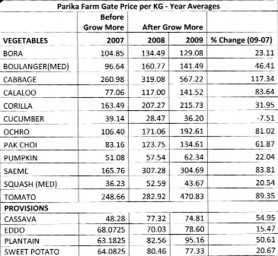 It must also be noted that the Government of Guyana is constantly seeking new markets for agricultural products; however, this is not an easy task as our own sister states are proving very tough markets to access. At the Caricom level at the meeting of agricultural ministers this has been a sore issue with calls for the facilitation of trade within the region. We have even had the formation of a ministerial sub-committee comprising of ministers of agriculture of Guyana, St Lucia and Trinidad and Tobago to deal with the facilitation of agricultural trade.
It must also be noted that the Government of Guyana is constantly seeking new markets for agricultural products; however, this is not an easy task as our own sister states are proving very tough markets to access. At the Caricom level at the meeting of agricultural ministers this has been a sore issue with calls for the facilitation of trade within the region. We have even had the formation of a ministerial sub-committee comprising of ministers of agriculture of Guyana, St Lucia and Trinidad and Tobago to deal with the facilitation of agricultural trade.
Amazingly in a free trade zone within Caricom, we have to seek to establish protocols with countries to trade in specific products and this comes with a cost, as we have to bring their agricultural officials to visit the farms on a regular basis. This is not the case for exports to countries outside of Caricom.
Another issue is the standards that are required of us. With the elimination of tariffs, countries are utilizing more non-tariff barriers to prevent trade and the farmers must understand that we have to comply with these conditions. So when we say we want a product with uniform size, certain packaging requirements and which must be cultivated under certain conditions, it must be understood that these are the requirements of the buyer. I am sure, Editor, that you understand the concept of market orientation. Sometimes it is hard to change the mindset of farmers. So this has to be a gradual process, getting the farmers to conform to these standards.
So one must understand that even though we have invested so much in agriculture this is not a process where you will see results immediately. There are some results that will be noticed immediately, but the major goals will be achieved in the future. In fact, the implementation of some of the major components of the Grow More Food campaign is work in progress. Many of these plans are long term, not narrow and temporary as your editorial writer would want to wish. The transformation from a subsistence level to commercially viable agro-business sector is no ‘short-time’ experience; this requires vision, boldness and dedication.
One can understand the frustration of several farmers, but in a developing country with a scarcity of resources, one has to allocate these resources optimally to achieve the best results, and of course some persons will not immediately benefit from this, but I can assure you that for every farmer that is not satisfied there are tens more who have benefitted for our investment. Yes, there are access roads which are in need of dire repairs. We cannot ignore the fact that the Ministry of Public Works and the Regional Development Councils have been spending resources to improve these. If we had not had a long period of economic decline and neglect of agriculture, our country would have had all the resources to fix every access dam and other needed facility in every part of Guyana.
I’m sure that among its interviews, Stabroek News did meet farmers that were satisfied with our progress and we will be doing our own interviews and research as we continually do to obtain feedback from the farmers, for our approach is a bottom- up approach. Our extension services have been revamped to serve this purpose, to be continually in contact with the farmers, receiving their inputs as we tailor their needs and adapt our research and technology to maximize their production.
I would hope that Stabroek News would continue to monitor our progress and I assure you that all our goals would be achieved and Guyana would continue to maintain its position as the only food secure nation and a major agricultural player within the region.
Finally, Editor I quote the following from two internationally recognized institutions:
“The roots of the recent food security crisis go back almost 30 years, when investment in agriculture started to decline because of the growing perception that agriculture was unprofitable” – the International Fund for Agricultural Development. I trust, Editor, that the intent of your articles and recent editorial does not put Guyana into a situation that in the upcoming future, farmers and other agri-business investors will shy away from investing in agriculture.
In fact, data from the Guyana Office for Investment (GoInvest) shows that in 2007, 67 agricultural projects were being developed and at the end of 2009 152 agricultural projects were being worked on. This clearly shows, Editor, that more individuals and companies are investing in agriculture and its associated businesses.
And, I quote from the Wall Street Journal of September 26, 2010, the following: “Developing countries will need to boost agricultural investment to $209 billion a year, up 47% from the annual average between 1997 and 2007, to meet growing demand for food, the report from the Asia Society and the IRRI says.”
“This year’s surge in food prices shows that ‘2008 was not just a blip, this is the way things will be, with repeated shocks’ in the years to come, says Robert Zeigler, director general of the International Rice Research Institute.”
With the global situation being susceptible to repeated food price shocks, we can only encourage our farmers to become market oriented, adopt the new production technologies and Grow More Food.
Yours faithfully,
Nizam Hassan
General Manager
Guyana Marketing Corporation

